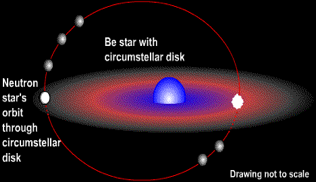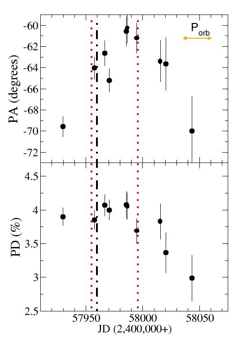Warped disks during giant outbursts in Be/X-ray binaries: evidence from optical polarimetry
Drs Pablo Reig and Dmitry Blinov of the Institute of Astrophysics have found the first evidence of precessing warped disks from polarimetric observations of the Be/X-ray binary 4U 0115+65.

Be/X-ray binaries are accreting pulsars, in which a neutron star orbits a Be star. The neutron star accretes matter from its companion and generates hard X-rays. When, active these systems are among the brightest in the X-ray sky, with peak luminosities of LX~1038 erg/s during outbursts. The source of matter available for accretion is the circumstellar disk around the B star's equator. Although there is general consensus that the outbursts are caused by the mass transfer from the Be disk to the neutron star, the detailed mechanism is uncertain. In particular, it is still a matter of debate how the Be disk links to the X-ray activity. We observe giant X-ray outbursts in systems with large and small disks. Likewise, systems with large disk show no X-ray activity.

The current idea is that the giant outbursts occur when the neutron star captures a large amount of gas from a warped, highly misaligned and eccentric Be disk. The models show that highly distorted disks result in enhanced mass accretion when the NS gets across the warped part.
We have found the first observational evidence for warped disks during an X-ray outburst using polarimetry. The light coming from the Be star is linearly polarized. Linear polarization results from Thomson scattering, when photons from the Be star scatter with electrons in the Be disk. The light becomes polarized perpendicularly to the scattering plane, which roughly coincides with the plane of the circumstellar disk. The polarization angle then gives information about the orientation of the disk. Therefore, if X-ray outbursts In Be/X-ray binaries require tilted, misaligned, warped eccentric disks that precess, then the polarization angle should change.
The illustration to the left shows the variation of the polarization angle and polarization degree with time during the course of an outburst. The data were obtained using the RoboPol polarimeter at the 1.3-m telescope of the Skinakas Observatory.
We interpret this variability as evidence for a warped precessing disk, supporting models that predict highly perturbed disks as the origin of giant outbursts in BeXB.
Article: Warped disks during type II outbursts in Be/X-ray binaries: evidence from optical polarimetry, Reig P. & Blinov D. 2018, A&A 619, A19
